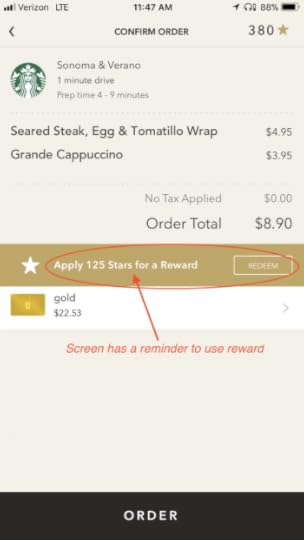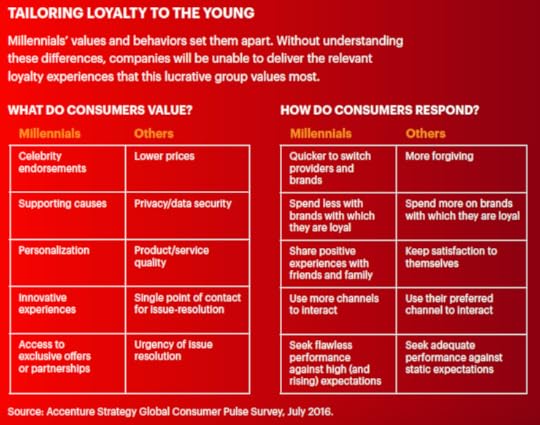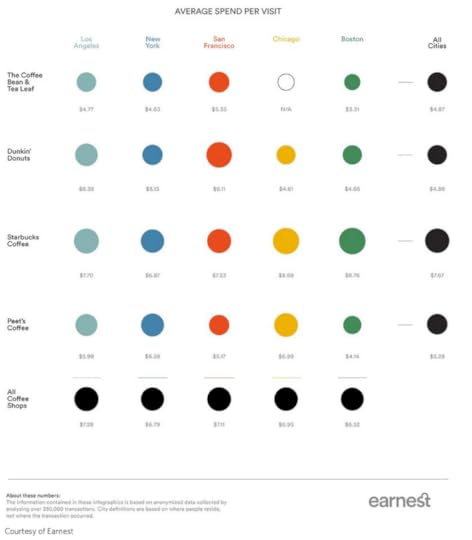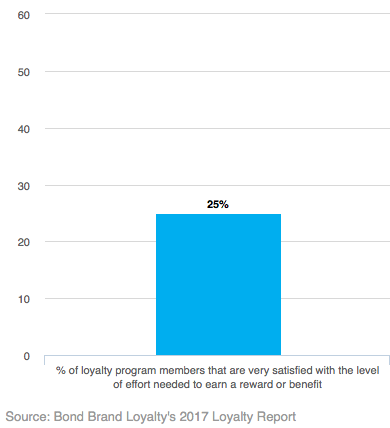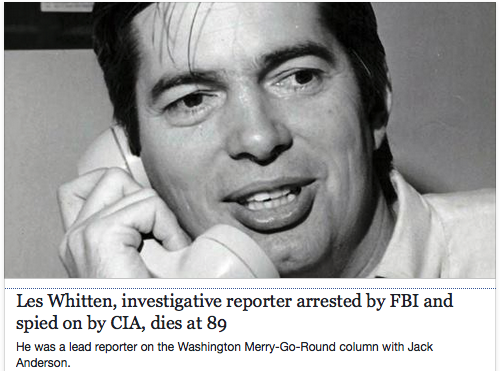Lewis Perdue's Blog, page 5
January 25, 2020
Case history: Starbucks
Why Starbucks as a case history?
14.2+ million active loyalty members in the U.S. (SBUX: Q1 FY 2018)
41% of North American customers used a Starbucks card, while another 24% paid with Starbucks’ mobile app. (Motley Fool, 2016,)
“Starbucks loaded around $1.6 billion on gift cards this past holiday season, and the company estimates that one in seven Americans received one as a gift.” (Motley Fool, 2016,)
The Starbucks interface is also acknowledged as the best and most integrated in the business.
Click graphic to view a larger image.
Click graphic to view a larger image.
This reward cost SBUX $1.97 to fulfill
Why would Starbucks want to participate?
Financial: Offload deferred revenue/liability
Increase value and usefulness to users
Good PR: Supporting (fill in the blanks: good journalism, entrepreneurs, small business, etc. Especially valuable if points are designated to “media” category).
Customer satisfaction: Expiring points and/or rewards seems like theft to customers. Auto-shift to VCH at a discount.
Promotion: VCH would allow a “gift a friend” ability to transfer rewards. Double reward voucher if friend is not an SBUX rewards member.
Continue SBUX as an innovator
Make a difference/Goodwill: Donate rewards to charity
Promotion: Store competition to see whose customers can donate most rewards to charity.
Be even more indispensible to Millennials and the upcoming iGen while maintaining loyalty of other demographics.
After the release of SBUX: Q1 FY 2018 on January 25, 2018, many analysts said that Starbucks needs to create a new “upper scale” tier of users. They (and other loyalty rewards companies) could easily “go platinum” by using VCH to offer access to paid content via a new rewards schedule.
What would it actually cost SBUX?
“CFO Scott Maw says the company averages more than 80% gross margin on its beverages,” –Source: Motley Fool, Jun 27, 2017
“The margin on food items, however, is just over 50%. So, if food becomes a larger percentage of sales, investors should see a decline in gross margin. But despite the increased emphasis on food over the last few years, cost of sales as a percentage of revenue has actually fallen from 43.7% in 2012 to 39.9% last year.
Starbucks Rewards, customers earn two stars per dollar spent, receiving a reward after earning 125 stars”…. $62.50 needed to earn a reward. — Source: Starbucks. Therefore, a point costs the loyalty member $0.10.
Nationwide, the average spend per visit is $7.67. — 2015, Credit card transaction study by finance company, Ernest, as reported by Eater (see chart, at bottom).
So, if the average reward has a purchase value of $7.67 then, at a 39.9% cost of sales, fulfilling a reward costs SBUX $3.06 to fulfill.
However, that average price could include customers who buy a drink and something to eat. The Starbucks reward program specifies EITHER a free drink OR free food item. Menu prices available at #HackTheMenu and Real Menu Prices show a wide range.
Assuming that a reward recipient goes neither for the least expensive, nor the most expensive item, $4.95 would seem a reasonable target. at a 39.9% cost of sales, that makes for a more realistic $1.97 cost of fulfillment.
Starbucks or Dunkin’ Donuts? Where America’s Coffee Loyalty Lies
Index of all documents
Value Clearing House – Summary
First goal: save American journalism
Why is news a good first entry into digital content loyalty payments?
Why would companies who offer loyalty programs like VCH?
Case history: Starbucks
VCH can solve most loyalty program dissatisfaction issues – incentive for corporate participation
How does VCH work?
Solution: Monopoly money for Monopoly digital content — The San Quentin wrapper solution
Proprietary and confidential information of Lewis Perdue. Not to be disclosed to or shared with third parties without written permission.
Solution: Monopoly money for Monopoly digital content — The San Quentin wrapper solution
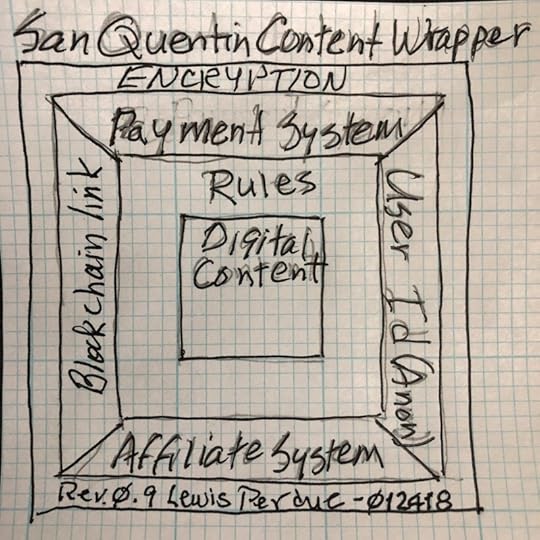
Click graphic to view a larger image.
San Quentin from VCH via is the solution: Single item, loyalty point purchase
Wrapper eliminates the complications and expense of installing and maintaining paywalls, payment systems and the need to sell through third-party sites such as the Apple Store, Google Play and other digital vendors who assess punitive charges.
System details to follow.
Index of all documents
Value Clearing House – Summary
First goal: save American journalism
Why is news a good first entry into digital content loyalty payments?
Why would companies who offer loyalty programs like VCH?
Case history: Starbucks
VCH can solve most loyalty program dissatisfaction issues – incentive for corporate participation
How does VCH work?
Solution: Monopoly money for Monopoly digital content — The San Quentin wrapper solution
Proprietary and confidential information of Lewis Perdue. Not to be disclosed to or shared with third parties without written permission.
Value Clearing House – Summary
4 problems:
[1] Corporations have a multi-billion-dollar deferred liability problem in loyalty rewards programs.
[2] Online media is starved for revenues.
[3] The majority loyalty members dislike many aspects of their programs
[4] Credit cards fail most online digital deliverables
1 Solution:
Value Clearing House
VCH is an open, integrated, secure, and block-chain-validated system to transfer deferred rewards liabilities into cost-effective micropayments for online digital goods such as content, games, music, videos, apps, and more.
VCH’s first goal is to solve the crisis in American journalism.
Significantly, the technology and system to accomplish that will open new financial opportunities for all digital goods and can improve nearly every existing loyalty program buy increasing satisfaction, customer engagement, and better accomplishing sponsoring company goals.
(1) Save American journalism
Online delivery has almost wiped out the news media … print and online
Online advertising is no solution. Problem is widespread, not just for newspapers
Something doesn’t ad up about America’s advertising market
It’s a global problem, not just the US
Consumers hate ads
Ads fail: Ad clutter, malware, data costs, slow page loads, and consumer annoyance in digital advertising have driven the rise of ad blockers
Digital ads just are not paying off for digital media
Digital ads mostly don’t work for the paying advertiser
Subscribers more profitable than ads
Deep discounting subscriptions further devalues news
Begging doesn’t always go over well (Even if you are well-known)
(2) Why is news a good first entry into digital content loyalty payments?
Media need
Consumer demand
Consumer satisfaction: Why VCH loyalty points work better than credit cards for digital content
Current online credit card payment systems are a hassle for consumers
Current online payment systems are a hassle for media sites
(3) Why would companies who offers loyalty programs like VCH?
Financial: Improve balance sheet & Income statement
Increase value and usefulness to users
Customer satisfaction: Expiring points and/or rewards seems like theft to customers.
Good PR: Supporting (fill in the blanks: good journalism, entrepreneurs, small business, etc. Especially valuable if points are designated to “media” category).
Promotion: VCH would allow a “gift a friend” ability to transfer rewards.
Promote company as a consumer-friendlu]u innovator
Make a difference/Goodwill: Donate rewards to charity
Be even more indispensible to Millennials and the upcoming iGen while maintaining loyalty of other demographics.
(4) VCH can solve most loyalty program dissatisfaction issues – incentive for corporate participation
Complexity and difficulty annoy 75%
“Point theft”
Lack of choice
Old Technology
Lack of value
What satisfies loyalty members? How does VCH fit in?
(5) Case history: Starbucks
(6) How does VCH work?
(7) Solving single item sales: The San Quentin digital content wrapper
Index of all documents
Value Clearing House – Summary
First goal: save American journalism
Why is news a good first entry into digital content loyalty payments?
Why would companies who offer loyalty programs like VCH?
Case history: Starbucks
VCH can solve most loyalty program dissatisfaction issues – incentive for corporate participation
How does VCH work?
Solution: Monopoly money for Monopoly digital content — The San Quentin wrapper solution
Proprietary and confidential information of Lewis Perdue. Not to be disclosed to or shared with third parties without written permission.
VCH can solve most loyalty program dissatisfaction issues – incentive for corporate participation
“In the U.S., [companies] spend $50 billion annually on loyalty programs; they’re just not hitting the mark,” Capgemini study author Mark Taylor.
2017 Bond Brand Loyalty study (with Visa) shows consumers are evaluating their loyalty program experience on elements far beyond the dividend and rewards. Members who find their loyalty program to be enjoyable are 10 times more likely to be satisfied, yet only 31% feel this way.
According to Capgemini Consulting (via CNBC)
“[T]he average U.S. household belongs to more than 21 loyalty programs.
Shoppers actively use fewer than 50 percent of the rewards programs to which they belong.
On social media nearly 90 percent of the conversation around loyalty programs is negative.
Complexity and effort annoy 75%
“Point theft”
Companies go out of their way to convince loyalty program participants that the points received from expenditures are valuable. They use words like “earned” to give that a psychological boost. That works against the company when it expires points or changes the program to devalue points. Participants feel robbed and cheated. (How airline loyalty programs seduce and abandon you)
Old Technology
Capgemini’s study: although 79 percent of loyalty programs use mobile strategies to target shoppers, less than a quarter allow them to redeem rewards through the technology. This makes it difficult for consumers to easily bounce between the web and the store while shopping, and can cause retailers to miss out on a potential sale.
Lack of choice
Limited selection of rewards to cash in points for
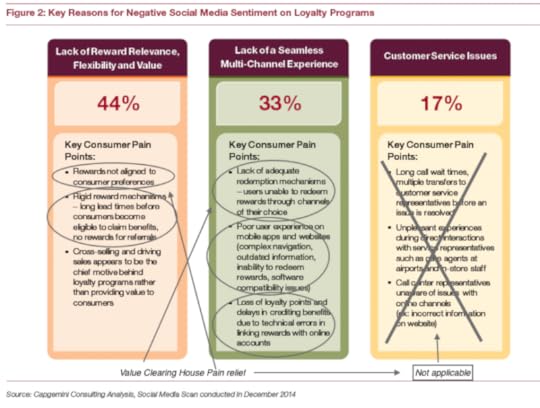
Source: Capgemini: Fixing the Cracks: Reinventing Loyalty Programs for the Digital Age (pdf)
Lack of value
Lack of perceived value in point “purchases.” — In addition to the difficulty often experienced in obtaining rewards for points, and lack of choice of merchandise that can be had for points consumers often feel that the merchandise being offered is over-priced — that the consumer is not getting value for their value points.
Physical merchandise is difficult to price for a purchase using points because there is a fixed cost of the merchandise as well as the shipping costs. This is especially annoying because consumers consider free shipping a modern-day birthright: The most important factor in online shopping.

What satisfies loyalty members? How does VCH fit in?
Further reading
6 Things I Hate About Loyalty Programs – FICO, Consultant Tim Young (Tim Young is a principal consultant at FICO. Tim has over 15 years’ experience spanning banking, finance, retail and marketing analytics. )
Best Loyalty & Rewards Programs: Top Marketing Experts
Index of all documents
Value Clearing House – Summary
First goal: save American journalism
Why is news a good first entry into digital content loyalty payments?
Why would companies who offer loyalty programs like VCH?
Case history: Starbucks
VCH can solve most loyalty program dissatisfaction issues – incentive for corporate participation
How does VCH work?
Solution: Monopoly money for Monopoly digital content — The San Quentin wrapper solution
Proprietary and confidential information of Lewis Perdue. Not to be disclosed to or shared with third parties without written permission.
February 20, 2018
Publisher incompetence and greed over “in print” can lead to bad reviews
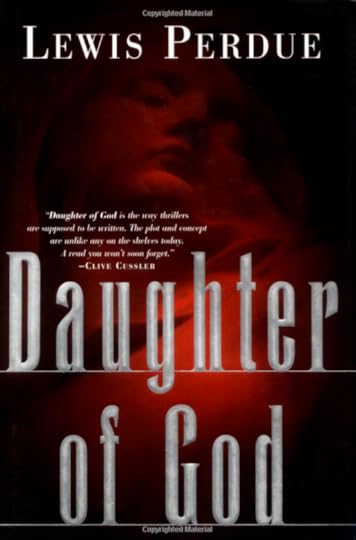
Right-click image to view in a larger format.
Daughter of God remains a reader favorite as evidenced by a long and continuing stream of emails and social media posts that continues to this day — 18 years after it was first published in hardcover by MacMillan/Forge/Tor.
But a huge problem has arisen over the publisher’s lame attempt to technically keep the book in print. The contract says I can’t get the rights back as long as the book is in print.
So, the publisher has foisted a pathetically flawed Kindle and on-demand paperback at Amazon (Daughter of God Kindle Edition).
Sadly, a number of contacts from readers say their reading experience was ruined by those versions which are sloppy, and filled with numerous scanner artifacts that that they have been too lazy and/or incompetent to correct.
Edited by a kindergarten student!
Not surprisingly, a substantial number of unfavorable reviews are recent, and involve publishing mistakes, not the story or writing. (bad news, good news … still bad)
I have to agree with the reader who left the following comment:

Right-click image to view in a larger format.
Buy used instead
Used hardcovers and mass-market paperbacks are available at Amazon and other used book sellers and will offer a good experience not marred by publisher incompetence.
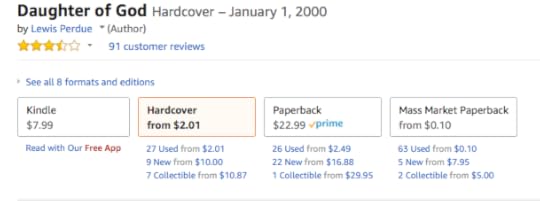
Right-click image to view in a larger format.
So why don’t I sue them?
Daughter of God has had way too many legal actions. I’m done with that.
Back in 2003, hundreds of readers emailed me to say that they felt The Da Vinci Code had plagiarized Daughter.
After reading Code, I wrote Random House and suggested — politely — that online and in a future edition, they give me credit. I didn’t demand money or threaten to sue. However, they eventually spent more than $300,000 suing me and asking a New York Court to declare that Code was non-infringing.
No jury, no experts, no evidence
After the judge refused my requests to allow the world’s foremost forensic linguist to testify, denied several university experts a hearing, and ruled out all of the emails from readers who saw plagiarism, and denied a jury trial, he ruled in favor of the Code publisher, Random House.
Random House later asked the court to make me pay their legal fees. But a small measure of justice was done when an impartial Federal magistrate — charged with determining whether I should pay them $300,000+ in legal fees they spent to sue me — said no, that my case was proper and well-founded.
Lengthy Vanity Fair investigation comes down unequivocally: Plagarism.
Investigative reporter Seth Mnookin (Newsweek, Vanity Fair) was one of the very few people who looked beyond Random House’s spin doctors and high-priced lawyers and into the facts of my verified plagiarism action against Dan Brown and the Da Vinci Code.
As Mnookin’s Vanity Fair article points out, the plagiarism was clear and seen by people from across the globe. The piece also shows how Random House “won” their legal case in New York only by exploiting a technicality that excluded the the smoking gun evidence that proved the plagiarism. One more victory for those who can afford to buy a court decision with big-money lawyers.
No more courts: Justice is too often bought and sold.
In a great example of how courts are all-too-often institutions of the personal whims of the judge instead of the law itself, the magistrate went on at length about how plagiarism seemed to have been present.
Indeed, a jury trial — which I requested and was denied in NY — would have been mandatory (along with expert testimony) if I had sued Random House here in California.
We are not a nation of laws. We are a nation of judicial whims which vary widely from one jurisdiction to another. While justice often does come from a court, only a fool should expect it.
January 9, 2018
Excite and eBay: Flirting With Disaster? Firearm sales may pose a potential litigation time bomb for eBay, Excite and perhaps other Internet auction sites
 (see also: Why eBay Alone Draws Fire in Online Auction Probe)
(see also: Why eBay Alone Draws Fire in Online Auction Probe)
Tactical Police Shotgun … Remington 870 Police Magnum 12-gauge shotgun with Surefire Model 618 Tactical Light. Weapon is solid black with a parkerized finish. Light is operated by a touch pad located on the pump. Shoots buck shot or slug. — For sale at Excite, Jan. 22, 1999
Searching the Internet auction sites for guns and roses could get you a grunge rock CD, flowers or, amazingly enough, a tactical police shotgun. Unfortunately, buying a firearm through eBay ( EBAY) or Excite ( XCIT) is discouragingly easy.
Depending on whether the buyer or the seller are properly licensed, it also may be illegal for the end parties if neither is properly licensed, and it may pose a potential civil liability time bomb for the sites offering guns for sale.
“Internet auctions are a secondary source of gun sales that can allow criminals to slip through the cracks,” says Will Winton, a spokesman for Handgun Control, Sarah Brady’s activist group, which has helped push through legislation for longer waiting periods and stricter background checks for gun purchasers.
“When you close the legal avenues so that criminals can’t buy weapons through legal outlets, criminals turn to gun shows and Internet auctions.” A search of auctions on eBay and Excite found a number of firearms and ammunition for sale including assault rifles and police-style combat shotguns.
The problem, according to Jeff Roehm, chief spokesman for the Bureau of Alcohol Tobacco and Firearms, is that while the advertisement of a firearm for sale is not illegal, the sale of a firearm between two unlicensed parties is a felony for the buyer or the seller — although it would not lead to criminal liability for any intermediary, such as eBay or Excite.
Roehm did say that Internet sales could become an increasingly popular place for criminals to obtain weapons, especially now that a federal task force is developing ways to crack down on gun shows. Many of the guns listed for sale on eBay are offered by people who claim to hold a federal firearms license, or FFL. Or some ads specify that the guns must be sold to an FFL licensee.
eBay would not comment on this story, including on whether it takes steps to verify whether gun sellers or buyers are properly licensed. Moreover, it is difficult for outsiders to know if the gun buyers or sellers are, in fact, properly licensed.
As for Excite, none of the firearms listings state that the seller is, or that the buyer must be, properly licensed. That may be a problem. According to lawyers familiar with this area, if an individual bought or sold a weapon without either party possessing an FFL, then eBay, Excite, or any other online site which facilitated the transaction could find themselves named as co-defendants in any personal injury or wrongful death lawsuits that arose out of that firearm’s use.
Attorneys experienced in personal injury or gun-control litigation say that if a gun purchased through these Internet systems is used to injure or kill someone, the online provider would almost certainly be named as a co-defendant. This remains an untested area of the law.
“In most of the situations you can imagine, there would be a strong case against the auction sites under a negligence per se theory,” says attorney D. Cameron Baker from San Francisco-based Morrison & Foerster. Baker is taking a leave of absence to work with the San Francisco City Attorney’s office on a gun violence project.
“I would think it’s virtually certain that any Internet site that facilitated the sale would be named in any subsequent litigation.” The auction sites at eBay, Excite and Yahoo! ( YHOO) all post their terms of use. Yahoo!, which specifically forbids the sale of firearms in its auctions, has only two antique firearms from the 19th century listed. Excite’s terms and conditions warn against “dangerous” or “illegal” products, and while it specifically mentions alcohol as a forbidden product, it does not mention firearms.
As of Friday evening (8 p.m. EST), eBay had no list of forbidden products in its terms of use, let alone a reference to firearms. None of the terms of use for any of the three services, incidentally, requests or requires a user to show any proof of actually possessing an FFL. Ironically, preventing the online sale of firearms would be a trivial task for a Web site’s software.
It could easily be accomplished by screening new listings for the relevant text, such as “tactical police shotgun,” “assault rifle,” “.44 magnum,” and so on. When contacted for comment, eBay’s VP and legal counsel Michael R. Jacobson said he was not available for comment until next week, according to his assistant.
When contacted for comment, Excite’s legal department offered a lengthy reply, paraphrased here as: “Classifieds 2000 intends to comply with all applicable rules and regulations. If we discover that a user of our service is not complying, we intend to take all commercially reasonable efforts to cease that use and prevent similar recurrences.”
Perdue helped found three technology companies in roles ranging from marketing to Chairman/CEO. Two of these sold: SmartWired, (Internet content), to private investors, Kalpana (Ethernet switching) was acquired by Cisco for stock, and the third, Lynx Real-Time Systems, is still private. He has written widely on technology for InfoWorld, PCWorld, Interactive Week, Forbes ASAP and many others. He can be reached at lperdue@ideaworx.com. He does not hold any positions in the companies discussed in this column. Under no circumstances does the information in this column represent a recommendation to buy or sell stocks.
December 29, 2017
Les Whitten – Tribute
See also: What The Argo Movie Got Wrong About Shredded Documents
I originally posted the text, below on James Grady’s Facebook page the day after Les Whitten died. Jim is a good friend — and former investigative reporting co-conspirator who knew Les even better than I did.
The last time I saw Les was March 30, 1981. I was teaching journalism at UCLA and was the advisor to the Daily Bruin.
I was in DC with a group of student editors attending a conference. I got a bit of free time right after lunch, and went over to the old Victorian house Jack Anderson used for his offices. I was sitting with Les and a group of reporters shooting the shit when a phone call came in for Les.
It was the Hearst Washington Bureau asking if there was anyone there available to cover the assassination attempt on President Reagan which had just happened.
I got the nod and headed over to George Washington Hospital where I bribed the parking lot attendant to let me use his phone (this before cell) to call in updates before heading over to Hearst to write my story. Now wish I had more time to have spent with Les.
Here are some PDF’s of old clips from my Jack Anderson/Les Whitten/Jim Grady era:
KoreagateTongsunPark-Post-Anderson
BettingOperationCongress
December 10, 2017
Mississippi Memories and the new Civil Rights Museum in Jackson
The opening yesterday of the new Mississippi Civil Rights Museum dredged up some memories, both old and new.

Illustration from The Nation, Jan. 1, 1973, “Mississippi: A Giant Step to Moderation,” By Lewis Perdue
And that led me to dig up the following article written after I graduated from Cornell back when when I was sure I would never live in Mississippi again.
March Against Fear
Key among those memories were the afternoon of June 25, 1966 when Arthur Hewitt and I drove to Madison to be spectators and get a chance to see Rev. Martin Luther King, Jr. and James Meredith as the March Against Fear as it made its way along US 51, north of Tougaloo where the marchers planned to stay overnight before heading into Jackson.
As things happened, a car full of school teachers had overheated because the day was very hot and the car was idling at a walking pace in the march.
When they pulled over, Arthur and I talked to them. They explained that the car had been having overheating problems and so had been carrying containers for water that they added periodically.
They had run out of water, so Arthur and I went to a nearby house. While we were refilling, the homeowner came out with a shotgun and chased us off. We ran to my car and drove off. The homeowner pursued. We eventually lost them after a chase on some pretty bad gravel roads.
The next day, I went back to join the marchers as they made their way along North State St. — which was the route that U.S. 51 took through Jackson.
It took me a while, but I took those feelings, wrapped them up in my Mississippi Delta family history and tucked them into a thriller called PerfectKiller which I had to wait for my Mama to die before I could write it.
July 31, 2017
Major excavation & fill destroying wetlands and seasonal tributaries of sediment-impacted Sonoma Creek.
This post was sent to the San Francisco District of the U.S. Army Corps of Engineers. I attempted to email this, but their email form cut off most of the email.
NOTE: All images can be enlarged by clicking on them.
I emailed your regulatory link last week about construction and excavation activities in El Verano that will most certainly impact Sonoma Creek less than a mile from the affected areas.

My message contained a link to this Corps map and indicated the general area of the activities: http://ideaworx.com/WOTUS-Disturbance-SonomaCreekTributaries.png
I have not heard from anyone.
I’ve uploaded a number of photos of this and other impacted areas to the web since then.
The ones below — taken on Friday, July 28, 2017 (except two which note they were taken July 23) — illustrate just two sites of many such in this area.
All the photos, below, look toward the east.
The two photos below are on the east side of Orange Avenue Between Grove and Solano.
The area is soggy much of the year — has persistent standing water in rainy season — and drains to seasonal creeks to the left (south) and east. It has taken more than three feet of fill to raise the building site above the water level.

The two photos, below, are of a site on the east side of Orange Avenue Between Grove and Craig. This site, too, has been too soggy to build on without fill.
The first one below shows a substantial seasonal stream on that begins at the lower left of the photo and runs diagonally to the right (south) side of the photo and then along the fence and trees.
As you can see, it is impossible to see the building site because of the fill already dumped.
Below is a July 23 photo that shows another view of the seasonal creek — the channel is 2 to 3 feet deep at the shoulder of Orange Avenue — and runs from the foreground through the middle of the fence posts and pretty much straight below the excavator near the fence.
Below is a wider view of the site with fill in progress:
And below is a wider view from the north side of the property, looking east (taken July 23)

https://www.flickr.com/photos/lewperdue/36243706905/in/album-72157684199762254/
These sites — along with others in this area — have not only destroyed habitat, but also eliminated those seasonal runoff areas that filter sediment running off from the hills to the west.
This situation means that the seasonal streams in both cases will not drop their sediment loads here, but be carried directly to Sonoma Creek which is already heavily impacted and less than a mile away.
I would appreciate a reply stating whether these are areas of concern, and if so, what might be the appropriate action.
As I stated in my email last week, I will be happy to give you a tour of these and similar areas that are being adversely impacted and which will make Sonoma Creek even less habitable for salmon and other aquatic species.

